
Believe it or not, the wealth of legal knowledge in your head is not just valuable in the courtroom — it’s a powerful tool for marketing your law firm.
Despite the obvious benefits of content marketing, only 37 percent of law firms report having a blog, a cornerstone of any content marketing strategy.
This is notable as original and compelling content is the key to captivating three critical audiences: Google, potential clients, and your peers.
The effectiveness of your law firm’s digital marketing strategy relies on the quality and consistency of your content. And content marketing is an equal playing field — you don’t need to be a large firm to create impactful content that answers your clients’ central questions and secures a top spot in search engine rankings.
In this article, you’ll learn:
Let’s dive in.
Content marketing is a strategic approach focused on creating and distributing valuable, relevant, and consistent content to attract and retain a clearly defined audience—ultimately, with the goal of driving profitable customer action to your law firm.
For lawyers, that means translating your legal expertise into accessible, engaging content that not only informs but also connects with potential clients and peers.
This strategy involves using various content marketing distribution channels to reach and engage a diverse audience, highlighting your legal expertise and building trust with potential clients.
Effective content distribution channels include:
By using a variety of content types, you can cater to different audience segments and attract different groups of potential clients.
The goal is not just to market your law firm’s services but to build trust and establish your firm as a go-to resource in your field.
Long gone are the days when there were only a handful of legal services in your city. The market is now hypercompetitive, and content marketing is a great way to cut through the noise and collect leads.
In fact, blogging frequently (+10 times a month) has been proven to bring in up to three times more leads than infrequently blogging.
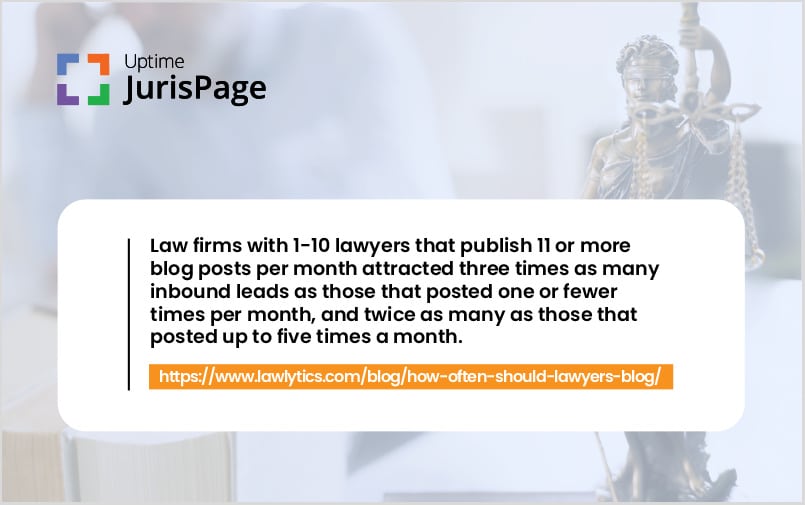
https://jurispage.io/best-law-firm-websites-that-nail-design-trust-and-conversion/Because there are so many law firms to choose from, clients now seek lawyers who understand their needs, speak their language, and are accessible — all traits you can communicate through content marketing.
Before picking up the phone and contacting you, visitors to your law firm’s website, blog, Facebook page, or YouTube channel check your credentials.
Here’s how your content can make a significant impact on prospects:
Let’s look at an example from Spectrum Family Law in Calgary.
Say you need an answer to the question, “Can a spouse in Calgary sue for adultery?” When you type it into Google, you’ll see something like this.
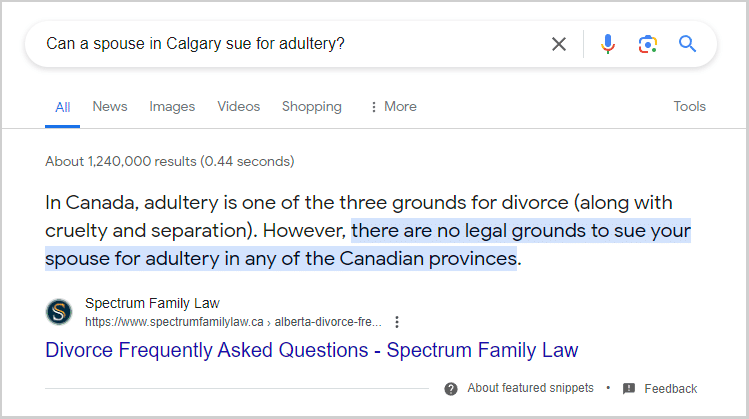
Spectrum Family Law’s answer to this question is in the featured snippet at the very top of the page.
You’ll be taken to the FAQ page on this firm’s website by clicking the link.
While you’re on this page, you can check out the answers to a few more questions about divorce in Calgary:
You now have the answer to your main questions and are ready to hire a family divorce lawyer.
At this point, Spectrum has demonstrated its expertise in an area where you need help. You’d likely go ahead and contact them.
The case for content marketing is convincing and is strengthened by the fact that it’s essentially free advertising for your firm.
You often have to pay a handsome price for billboard advertising or pay-per-click advertising for lawyers. But Spectrum Family Law does not pay for its prime space in the featured snippet at the top of Google page one.
To sum it up, relevant, engaging, and compelling content can:
Google looks at two important factors when evaluating content that all law firms need to know about: YMYL (Your Money or Your Life) and E-E-A-T (Experience, Expertise, Authoritativeness, Trustworthiness).
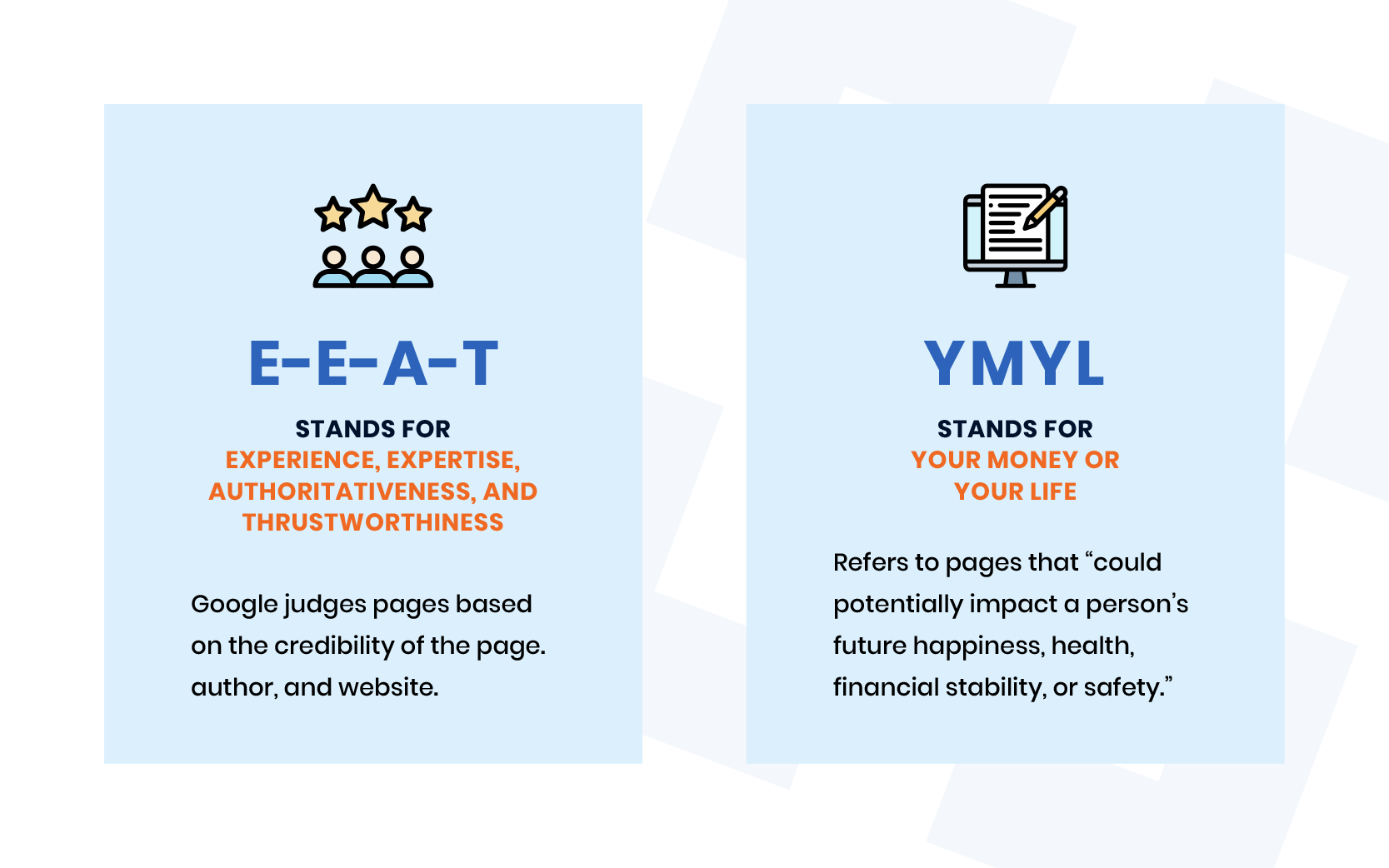
Understanding and applying these concepts is essential for law firms aiming to produce content that not only ranks well but also truly serves the needs of their audience.
YMYL refers to content that could significantly impact a reader’s health, financial stability, safety, or overall well-being.
Due to the profound influence this content may have on an individual’s life decisions, Google subjects it to rigorous standards of accuracy and reliability.
Legal content, with its direct impact on legal outcomes and financial decisions, falls under this category. That means your content needs to be of an even higher standard of care and thoroughness.
E-E-A-T represents the criteria Google uses to assess the quality of content, especially within YMYL topics.
These criteria ensure that content not only provides accurate and useful information but is also created by individuals or organizations with demonstrable expertise and authority in their field.
Here’s why each component is crucial for legal content:
Most legal content inherently falls under the YMYL category due to its potential to significantly influence readers’ lives, health, financial stability, or safety.
Google scrutinizes this content more closely, requiring it to be factual, up-to-date, and clear to prevent misunderstandings and ensure it serves the welfare and well-being of society.
For law firms, this means every piece of advice or guidance shared must be meticulously fact-checked and clearly explained.
Google prefers content that demonstrates strong E-E-A-T, especially for YMYL topics. This focus reflects the importance of not only providing trustworthy and authoritative information but also showcasing the depth of experience and expertise behind the content.
Here’s how law firms can navigate and emphasize these elements:
By understanding and applying YMYL and E-E-A-T principles, you can create content that balances the needs of both Google while genuinely educating your audience.
Let’s move on to the steps you can take to build your law firm’s content marketing strategy.
Creating impactful content begins with identifying topics that resonate not only with your firm’s practice area but also with your potential client’s needs and current legal trends.
You want to provide value to your readers — ranking on search engines is a byproduct of that, not the goal.
Thankfully, there are tools and tactics out there that can help you figure out what connects with your audience.
But the easiest (and best) place to start is with your own team.
Think about all of the questions prospects ask you and your team. What questions do you get asked over and over again?
Those questions come directly from the source and are where I recommend you start.
Your reviews are another place you can look for content ideas. Think about the positive and negative feedback you receive, the problems clients face while working with you, and what their pain points are.
Together, both of these tactics are a goldmine of opportunity.
In addition, think about:
Once that well has run dry, you can begin using tools to identify more questions.
First, head on over to Google and type a relevant query. I’ll use “criminal defense dui” as an example.
The autocomplete could reveal some questions you haven’t thought of.

Then there’s the “People also ask” section, a collection of questions Google thinks are relevant to your query.
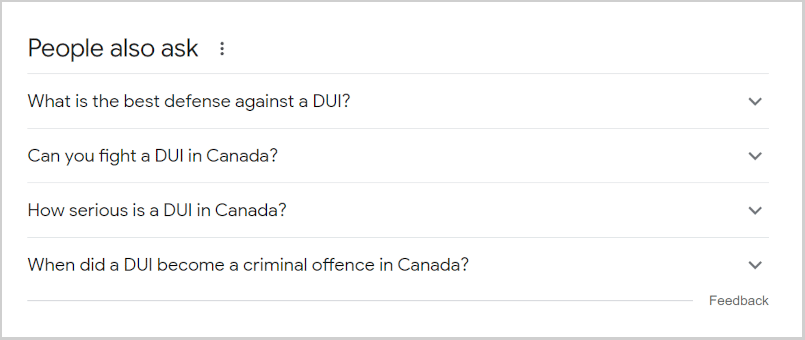
You can create content answering these questions. For example, write a blog post covering “how to defend a dui case” and then make a YouTube Short answering that same question.
Another tool I recommend is AlsoAsked. You simply type in your topic or keyword, and it outputs a list of questions that are both related to your query and are being searched for.
Here’s how it works.
You can then note all the relevant questions and add them to your content calendar.
At the heart of any successful content marketing strategy is a deep understanding of the audience.
For law firms, this means going beyond the surface level of client demographics to develop detailed buyer personas.
This step helps you really get into the mindset of your audience and address the specific questions and challenges they face.
Here’s how to get started on building your buyer persona.
You can then use that detailed buyer persona to inform all of your content. It should be easy to identify topics that your audience finds real value in.
Here’s an example of a filled-out persona.

Use the information gathered to address your personas’ most common questions and concerns. Each piece of content you create should provide clear, actionable advice and insights. The key is to provide value.
Another way to use your client persona is to shape the tone and format of your content. It should resonate with your personas’ preferences.
For example, if you regularly work with young people, short-form video content may resonate more than a long blog post.
On the other hand, individuals facing personal legal challenges (think family law, for example) might benefit from more empathetic, narrative-driven long-form content. This thoughtful customization of your content’s presentation can significantly boost engagement.
While I don’t recommend creating content specifically for search engines, you can’t escape doing keyword research.
After all, you want to optimize your content for long-term organic traffic.
At JurisPage, we’re partial to Semrush and Moz. I’ll go over how to do basic keyword research using Semrush below.
Once you have a list of keywords, you can decide what pieces of content should include which keyword.
I recommend taking it a step further and building content hubs around each of your main content themes.
If you serve multiple practice areas, each one could be its own hub. It’s a more organized way of creating content around one theme that benefits both users and Google.
These hubs serve multiple purposes: they enhance the user experience by making it easier for visitors to find all related information in one place, they demonstrate the breadth and depth of your expertise in specific legal areas, and they improve SEO by creating a structured, interlinked content ecosystem that signals relevance and authority to search engines.
How?
Each content hub should represent a specialty of your firm and be built around a primary keyword. The supporting content, then, should target related long-tail keywords that address specific queries.
I bet you already know who your main competitors are. You can use that information to your advantage.
If they’re ranking well on SERPs, odds are they’re doing something right. By analyzing their content, you can uncover valuable strategies and tactics to inform your own content.
Assess the structure, format, depth, and breadth of their content. Notice how they address complex legal issues, the clarity of their explanations, and the persuasiveness of their arguments.
Pay special attention to the types of content (articles, blog posts, FAQs, guides) that resonate most with their audience, as indicated by engagement metrics like shares, comments, and backlinks.
For example, if a competitor gets a lot of views on their video content, then your audience might appreciate videos as well.
You can also use Semrush’s Organic Research tool to find a list of all of your competitor’s top pages.
From there, you can then identify gaps and opportunities in the market.
Each content hub should represent a specialty of your firm and be built around a primary keyword. The supporting content, then, should target related long-tail keywords that address specific queries.
Striking a balance between SEO-driven content and thought leadership or pain-point-led content is key.
Content designed to rank should follow SEO best practices.
Start by developing foundational content, such as comprehensive guides, overview pages, and foundational blog posts that introduce your firm’s key practice areas. This content should be evergreen, providing a solid base of knowledge about your services and legal expertise.
The Law Offices of Andrew M. Weisberg has a dedicated page for each of his practice areas, where prospects can learn about his services and experience in each area.
Building upon this, create informational content that dives deeper into specific legal issues, questions, or current trends. This includes FAQs, detailed analyses, and how-to guides aimed at providing thorough advice on pressing legal matters, ensuring they’re tackled with the highest degree of accuracy and authority.
He then expands on his practice areas by publishing informational content specific to his practice areas.
Use the keyword research you did in step 3 to inform both the foundational and informational content you create.
A good place to start with foundational content would be [practice area] + [city], like “family law lawyer in Los Angeles”
This dual focus ensures your content is discoverable by those seeking expertise in both the specific legal specialty and locality.
Use these keywords strategically within your content, titles, meta descriptions, and URLs to enhance SEO. However, remember the importance of natural language usage to maintain readability and engagement for your audience.
The most impactful content operates on a spectrum of SEO optimization. Some pieces may be highly targeted towards specific keywords to capture search traffic, while others might focus on addressing complex legal questions in depth, prioritizing client education over search visibility.
The goal is to maintain a portfolio of content that supports your firm’s visibility in search engines while establishing your reputation as a trustworthy and knowledgeable authority in your legal niche.
Law firms’ content falls squarely within the YMYL (Your Money or Your Life) category, recognized by Google for its potential to impact users’ happiness, well-being, or security. Essentially, Google takes extra steps to avoid ranking content that could provide a negative experience.
This means that law firm’s content is under more scrutiny than other content. It’s even more important that you showcase your expertise and authority so Google can tell that you’re qualified to give advice on legal issues.
Google’s algorithm is trained to search for a variety of qualities that signal whether a piece of content falls short of or satisfies E-E-A-T.
In practical terms, this means that your content should be written by subject matter experts (SME) and your website should make that obvious by showcasing bylines and having detailed author bio pages. Clearly identifying content authors, along with their qualifications and areas of expertise, reinforces the trustworthiness of your information.
This means:
Providing bylines and bios for authors, linking to detailed profiles that list credentials, relevant experience, and any accolades that establish their authority in the legal field.
Highlighting awards, testimonials, or endorsements on your site can serve as social proof of your firm’s reliability and quality of service.
Here’s a walkthrough of a great attorney bio by Oykhman Criminal Defence.
It’s not enough to publish one blog a month, whenever you have some spare time. Crafting and adhering to a consistent publishing schedule is crucial, especially for blogs.
Start by setting a realistic goal for yourself. Figure out what you realistically can commit to publishing and what your goals are, be it lead generation, educating clients, or thought leadership.
You can then document your plan in an editorial calendar. A singular place for you to figure out who’s writing what, when it’s being published, what keywords are relevant, and more. This calendar becomes the backbone of your content strategy, ensuring diversity in content types — from insightful blog posts to engaging videos and infographics — and keeping your content fresh and relevant.
I recommend Hubspot’s Editorial Calendar Templates as a great starting place.
Creating content is extremely time-consuming, so don’t overfill your content schedule. It’s better to be realistic and post once a week than to have an overly ambitious content schedule that you don’t end up following.
And don’t be afraid to delegate tasks. Other members of your law firm likely have expertise they could share, too.
If you have the budget, hiring a content team to help is even better.
Another way to expand your reach while establishing authority is to publish content on other blogs or journals.
Guest blogging and collaborations present a golden opportunity to expand. First, identify and connect with relevant blogs, journals, or legal industry partners whose audiences align with your firm’s expertise and target market.
Start by scouting for legal blogs, industry publications, and professional forums that welcome guest contributions.
Some common examples include:
A promising medium for expanding reach is podcasting. The truth is that there are podcasts in every niche, and many are looking for guests.
Clio’s Matter’s podcast, for example, frequently features practicing attorneys and law firm leaders as guests.
Making your law firm’s website and content both accessible and user-friendly is more than just best practice — it’s a vital part of good content.
To streamline the readability of your content, use clear and simple language that demystifies complex legal topics. Use subheadings and bullet points to make what could be complex legal information much more digestible for your audience.
Here’s an example of a well-structured blog post. Note the table of contents and headers that clearly explain what to expect.
It goes beyond just your blogs though. Navigating your website should be a breeze, with a logical menu structure that directs users to any information they could possibly be looking for. For instance, highlighting a section of your website dedicated to frequently asked questions with easy-to-follow answers can serve as a practical example of effective navigation.
The technical performance of your website also impacts the user experience. Fast loading times and mobile responsiveness are non-negotiable as Google measures your content against competitors — you need every advantage you can get.
Extending your content marketing beyond your website into other channels, like social media, is the key to expanding your reach.
Social media offers unique opportunities not just for content promotion but for cultivating meaningful relationships with your clients and nurturing leads.
But it’s easy to go astray with social media marketing. There are so many platforms, and I’ve heard that many lawyers don’t know what to post.
I recommend figuring out where your audience spends their time and investing heavily in that one platform.
For example, practice areas like family law and personal injury could be successful on Facebook, as it’s more community-centric. Whereas a corporate lawyer would have more luck on LinkedIn, as they want to reach other business professionals.
You should also share the content you create for other channels, like your blog, on social media to expand its reach. From there, you can begin posting more original content — commentary on legal issues, answering frequently asked questions, and sharing updates on the law, which are all great places to start.
All of this with the goal of becoming a trustworthy thought leader.
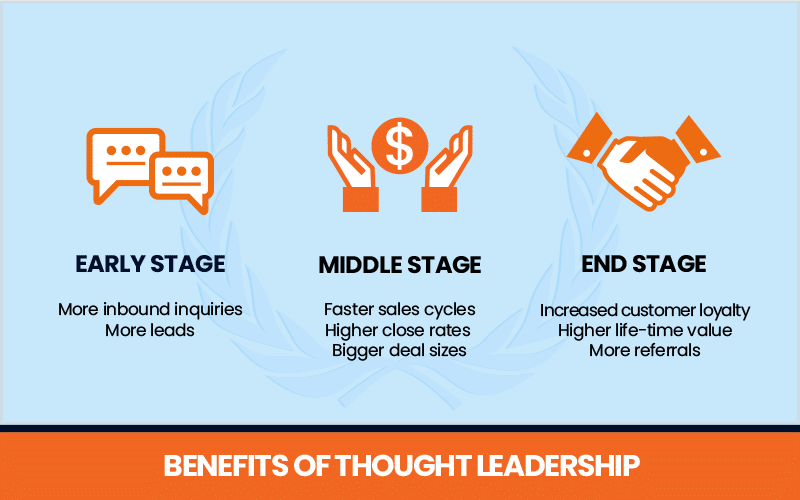
The reality is that artificial intelligence (AI) has become integral to digital marketing. If you want to stay ahead of the game, I recommend getting on board.
AI like ChatGPT can help even the best content marketer come up with relevant topics that resonate with your audience and fill in content gaps.
Here are a few ways I recommend using ChatGPT to your advantage.
ChatGPT can help you brainstorm, suggesting topics that are likely to engage your audience.
This predictive capability helps you to stay ahead of the curve, creating content that addresses your audience’s needs before they even arise.
Here are a few prompts to try.
“Can you suggest some upcoming legal topics that might be of interest to individuals facing [specific legal issue] based on current trends and discussions in the legal field?”
“Can you suggest some blog topics related to [practice area]?”
AI technologies can delve into search patterns and user behavior to understand the intent behind queries related to your practice areas.
This insight enables you to tailor your content to keywords and the specific needs and questions driving those searches, making your content more relevant and valuable to your audience.
“Given the search trends around [specific legal issue], what are some nuanced user intents behind these queries, and how can we tailor our content to meet these specific needs and questions?”
AI tools can assist in the content creation process, from generating outlines to suggesting headings and key points based on the topic’s online engagement history.
This support can significantly speed up the content production process, allowing you to publish timely, relevant content more frequently.
“Could you generate an outline for a blog post about [specific legal topic], including suggested headings and key points that align with high online engagement history for similar topics?”

“My website continues to dominate all the top website searches in my industry and my business has grown 10-fold as a result.”
Oykhman Criminal Defence
Google emphasizes the importance of creating content that prioritizes the needs and questions of people above search engine rankings.
That means old SEO and content marketing principles — such as targeting irrelevant keywords solely for search traffic and keyword stuffing — are no longer recommended. We also don’t recommend using AI to pump out as much content as possible.
Google’s algorithms have shifted to value content quality and relevance over things like keyword density.
Instead, law firms should produce content that genuinely helps your audience understand complex legal issues, navigate their legal challenges, and make informed decisions.
To ensure your content aligns with these goals, consider the following guidelines.
Regularly evaluate your content against Google’s criteria for helpfulness, asking if it provides original insights, comprehensive coverage of topics, and adds value beyond the obvious.
To determine whether your content is truly helpful, ask yourself questions like:
Focus on creating content that is thorough, well-researched, and clearly communicated, aiming to be a resource that users would bookmark, share, or recommend.
While I don’t recommend using AI to write entire blogs, it is a valuable tool for creating comprehensive outlines.
The custom GPT “Longform Blog Cyborg” can output highly detailed outlines with just a targeted keyword or topic. From there, you can compare it to what’s already ranking for your keyword and adjust accordingly, resulting in the more comprehensive piece of content out there.
Design your content to offer a good page experience so that it’s accessible, easy to navigate, and free from issues that could detract from the user’s ability to find helpful information.
This could involve making it accessible and easy to navigate, ensuring that it’s optimized for both speed and responsiveness across all devices. This means implementing clear, intuitive layouts, using headings for structure, ensuring fast loading times, and making your site accessible to all users, including those with disabilities.
A good way to test various elements of UX is through Google’s Core Web Vitals test.
Implementing a people-first approach in content creation aligns with Google’s guidelines. Whenever you’re brainstorming a new piece of content, ask yourself: is this actually helpful to our audience?
The easiest way to make helpful content is to answer questions past and current clients have asked you. That is, think about questions you’re frequently asked and answer them on your blog.
For more information on all of the above, I recommend reading Google’s latest document on creating helpful content.
We’ve covered the research, creation, and promotion of your content. But the work doesn’t end there with content marketing,
You need to ensure that some of your content converts (calls to action should entice users to contact you, fill out a form, etc.). You also need to measure how the content marketing campaigns are going.
How do you measure the success/ROI of a content marketing campaign?
A recent survey found that over 40 percent of law firms do not track their leads at all. That’s criminal when we have all the tools we need to track every lead,
You should be looking out for the following content marketing metrics:
It can be difficult to measure awareness. It’s also tough to attribute leads to particular pieces of content, but you should get an idea of what’s working and what’s not by the nature of the leads coming to you.
Ask leads how they found you and use tools like Google Analytics to measure traffic, identify the most effective content and track conversions. Adjust your content marketing plan accordingly.
We also discuss setting up tracking and monitoring of metrics in chapter 8 of this guide.
Lawyers are realizing the value of content marketing in increasing awareness, establishing authority, building relationships, and producing more leads for their law firms.
That means it’s more competitive than ever and tougher for your content to stand out.
And that means you need to do it better than the rest.
But it’s a long game. Most law firms need to hand the task to seasoned professionals.
At JurisPage, we develop law firm content marketing strategies that make your law firm more visible and generate a steady stream of quality leads.
Ready to maximize your marketing budget? Fill out the contact form or call us today for a complimentary consultation. We will listen to your story, work to define your business objectives, and recommend an approach to deliver maximum ROI for your firm.
By using this website, you consent to our use of cookies in accordance with our Cookie Policy. Cookies help us enhance your browsing experience and provide personalized content. If you do not agree to our use of cookies, please adjust your browser settings accordingly.